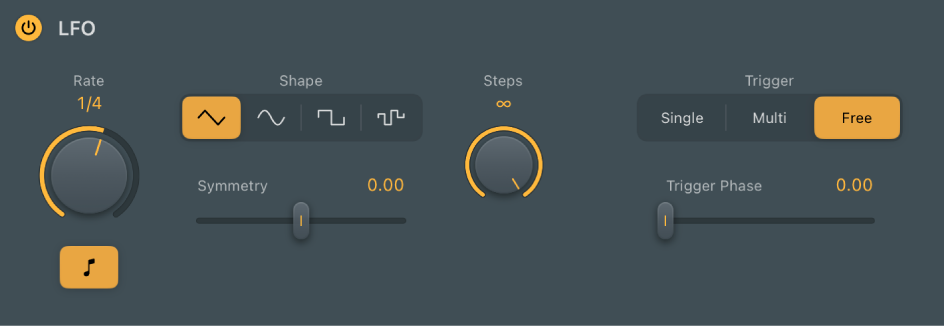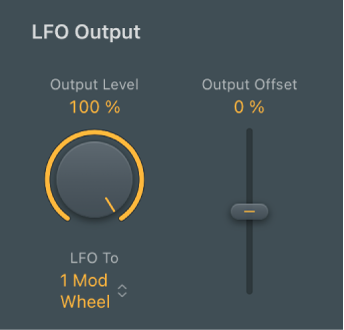Logic Pro User Guide for iPad
- What’s new in Logic Pro 1.1
-
- What is Logic Pro?
- Working areas
- Work with function buttons
- Work with numeric values
-
- Intro to tracks
- Create tracks
- Create tracks using drag and drop
- Choose the default region type for a software instrument track
- Select tracks
- Duplicate tracks
- Reorder tracks
- Rename tracks
- Change track icons
- Change track colors
- Use the tuner on an audio track
- Show the output track in the Tracks area
- Delete tracks
- Edit track parameters
- Start a Logic Pro subscription
- How to get help
-
- Intro to recording
-
- Before recording software instruments
- Record software instruments
- Record additional software instrument takes
- Record to multiple software instrument tracks
- Record multiple MIDI devices to multiple tracks
- Record software instruments and audio simultaneously
- Merge software instrument recordings
- Spot erase software instrument recordings
- Replace software instrument recordings
- Capture your most recent MIDI performance
- Use the metronome
- Use the count-in
-
- Intro to arranging
-
- Intro to regions
- Select regions
- Cut, copy, and paste regions
- Move regions
- Remove gaps between regions
- Delay region playback
- Trim regions
- Loop regions
- Repeat regions
- Mute regions
- Split and join regions
- Stretch regions
- Separate a MIDI region by note pitch
- Bounce regions in place
- Change the gain of audio regions
- Create regions in the Tracks area
- Convert a MIDI region to a Drummer region or a pattern region
- Rename regions
- Change the color of regions
- Delete regions
- Create fades on audio regions
- Access mixing functions using the Fader
-
- Intro to Step Sequencer
- Use Step Sequencer with Drum Machine Designer
- Record Step Sequencer patterns live
- Step record Step Sequencer patterns
- Load and save patterns
- Modify pattern playback
- Edit steps
- Edit rows
- Edit Step Sequencer pattern, row, and step settings in the inspector
- Customize Step Sequencer
-
- Effect plug-ins overview
-
- Instrument plug-ins overview
-
- ES2 overview
- Interface overview
-
- Modulation overview
-
- Vector Envelope overview
- Use Vector Envelope points
- Use Vector Envelope solo and sustain points
- Set Vector Envelope segment times
- Vector Envelope XY pad controls
- Vector Envelope Actions menu
- Vector Envelope loop controls
- Vector Envelope release phase behavior
- Vector Envelope point transition shapes
- Use Vector Envelope time scaling
- Use the Mod Pad
- Modulation source reference
- Via modulation source reference
-
- Sample Alchemy overview
- Interface overview
- Add source material
- Save a preset
- Edit mode
- Play modes
- Source overview
- Synthesis modes
- Granular controls
- Additive effects
- Additive effect controls
- Spectral effect
- Spectral effect controls
- Filter module
- Low and highpass filter
- Comb PM filter
- Downsampler filter
- FM filter
- Envelope generators
- Mod Matrix
- Modulation routing
- Motion mode
- Trim mode
- More menu
- Sampler
- Copyright
Modulator MIDI plug-in LFO in Logic Pro for iPad

LFO parameters
On/Off button: Turn the LFO on or off.
 Rate knob and field: Set the cycle speed of the LFO in hertz or in beat values when the Sync button is on. The LFO rate can be modulated by the envelope. See Modulator MIDI plug-in envelope.
Rate knob and field: Set the cycle speed of the LFO in hertz or in beat values when the Sync button is on. The LFO rate can be modulated by the envelope. See Modulator MIDI plug-in envelope.Sync button: Synchronize the LFO rate to the project tempo.
 Shape buttons: Select a waveform shape. Choose from: triangle, sine, square, and random. Each is suited for different types of modulations.
Shape buttons: Select a waveform shape. Choose from: triangle, sine, square, and random. Each is suited for different types of modulations.Symmetry slider and field: Adjust the symmetry of the waveform. This deforms the waveform in the following ways:
Triangle: Shapes the triangle waveform into either an upward-sawtooth or downward-sawtooth waveform. A symmetry value of 0 results in a perfect triangle waveform.
Sine: Changes the angle of the waveform, resulting in a sawtooth-like waveform with peaks that lean left or right. A symmetry value of 0 results in a perfect sine waveform.
Square: Symmetry acts as a pulse width control. A symmetry value of 0 results in a perfect square waveform.
Random Similarity slider and field: Adjust the amount of deviation when a random waveform is chosen. This alters the waveform in the following way:
Random: Similarity determines the maximum deviation between two consecutive random values. Low symmetry settings result in random values that are minimally different from one to the next, whereas high symmetry settings result in random values that deviate significantly.
Smoothing knob and field: Determine the number of steps per LFO cycle.
By default, the LFO produces a smoothed continuous stream of controller events, but you can use this parameter to create a stepped controller signal that is similar to the output of a Sample and Hold circuit. When you set a manual step rate, the LFO rate can be changed without altering the number of steps.
Trigger buttons: Determine how the LFO reacts to incoming MIDI note on messages.
Single: After all notes have been released, the LFO is reset by the first MIDI note on message it receives.
Note: This means that legato playing does not reset the LFO, so keep this in mind during performances.
Multi: The LFO is reset by each received MIDI note on message.
Free: The LFO ignores MIDI note on messages.
Trigger Phase slider and field: Set the LFO waveform phase startpoint.

LFO Output parameters
Output Level knob and field: Scale the LFO output level.
LFO To pop-up menu: Choose a continuous controller number, aftertouch, or pitch bend as the LFO output target. You can also learn a plug-in parameter.
Output Offset slider and field: Set a positive or negative offset in order to tailor the output for the intended target.
MIDI Channel pop-up menu: Choose a MIDI output channel.
Note: This applies to both the LFO and envelope.
Assign a MIDI event to a plug-in parameter
You can assign and send MIDI events to plug-ins in the same channel strip, allowing you to control parameters without using MIDI CC messages.
In Logic Pro, choose -Learn Plug-in Parameter- from the LFO To pop-up menu.
Tap the parameter in the target plug-in.
Download this guide: PDF